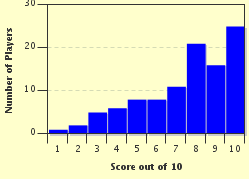Quiz Answer Key and Fun Facts
1. In the year 1495, this Italian Renaissance man used the anatomical knowledge he gained from creating the "Vitruvian Man" to design a humanoid robot, able to move its arms, neck, and jaw.
2. Today, remote controlled military vehicles such as UAVs (Unmanned aerial vehicles) , cruise missiles, and bomb diffusers are widely used to keep humans out of harm's way. The idea originated in 1898 when Nikola Tesla designed and built a small, radio controlled version of what vehicle?
3. In 1921, Czech writer Karel Capek coined the term "robot" in his science fiction play, "R.U.R." The acronym represents the name of a company in the play that produces robots to perform a variety of tasks. What does this acronym stand for?
4. One of the greatest and most prolific science fiction writers in history, this man famously created the Three Laws of Robotics in 1941.
5. Today, the industrial sector is by far the largest market for robotic technology. The first industrial robot was Unimate, created in 1961 for use on an assembly line in New Jersey. For which industry, currently the largest user of industrial robots, was it built?
6. Robots that look, move, and think like humans are commonplace in TV shows and movies. Some modern robots, while not quite as advanced as those appearing in science fiction, are capable of moving intelligently through their environment and socially interacting with humans. The first mobile robot able to reason about its actions was built at the Stanford Research Institute between 1966 and 1972 and named for its jerky motion. What was the name of this robot?
7. Robots have proven very useful in space where they are able to operate effectively in a harsh environment with minimal human input. While they do not fit the traditional image of a robot, robotic space probes are able to gain information about their surroundings using sensors and move accordingly using thrusters and gyroscopes. What are the names of the two probes, launched in 1977 to collect data on our solar system, that are known for producing many stunning photographs of the gas giants and their moons?
8. In 2000, the da Vinci Surgical System became the first medical robot approved by the U.S. Food & Drug Administration for use in American operating rooms. The robot consists of three or four arms, each with a different surgical instrument, that are controlled by a doctor from a console a few feet away. Which of these is NOT an advantage of operating with medical robots?
9. For hundreds of years, people have imagined and built robots that look and act like human beings. In 2000, Honda made a tremendous breakthrough in this field when it unveiled a highly advanced humanoid robot, the first to be able to walk on its own. What is the name of this robot?
10. In "The Jetsons," the family had a robot maid named Rosie who dispensed advice, cleaned the apartment and was often shown pushing around a vacuum cleaner. The first commercially available robotic vacuum cleaner was the Trilobite, released by Electrolux in 2001, but its less expensive and much more popular competitor was unveiled a year later by iRobot. What is the name of this well-known robot?
Source: Author
tiddybitnibbly
This quiz was reviewed by FunTrivia editor
crisw before going online.
Any errors found in FunTrivia content are routinely corrected through our feedback system.

